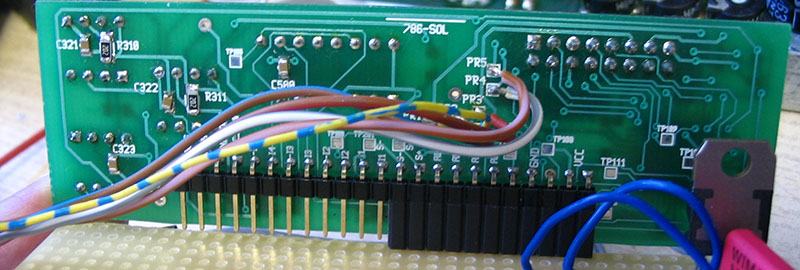[bekeband] recently came across an old industrial monitor. It’s small, monochrome, has a beautiful green phosphor, and does not accept a composite signal. Instead, there’s a weird TTL input with connectors for horizontal sync, vertical sync, and video. Intrigued, [bekeband] brought it home and started working on a project that would drive this monitor. He succeeded, and with a chip we don’t see much of on the Hackaday tips line: a 16-bit PIC.
The project uses the dsPIC30F3011, a strange little 16-bit PIC in a 40-pin package. The board for this build actually comes from an earlier build, and after connecting the horizontal sync, vertical sync, and video to this tiny board, [bekeband] started writing some code.
There are two programs written for this board. The first is a static image tester that displays a single image on the CRT. The second is one that displays a simple animation, in this case, a horse running in place. It’s not the fanciest project, but it does work, and even though [bekeband] isn’t using a high-speed ARM, he is getting a reasonably high resolution out of this chip.
Video below.















The PIC 16 traditionally refers to the old 8-bit core. The 16-bit ones are the PIC24 and dsPIC (in this case, the dsPIC30 series)
Yet another HaD fail.
Oh wise one, tell us how to live without making mistakes at any time! I beseech thee! Reveal your secrets!
Grasshopper, the secret is not to avoid making mistakes, but to FIND and FIX your mistakes BEFORE you publish them! When done correctly, not only will your reputation increase, but you will also be less likely to make the same mistake a second time. Now, back to your training!
You clearly have not worked under deadlines.
Now, who’s the know-it-all?
If you can’t produce a quality product under a deadline, maybe you’re in the wrong line of work.
Anyone can produce a quality product under deadline, but do you have more than one deadline per week? Publishing on a blog like this isn’t a one product per year affair, it’s an 8 deadline per day affair.
Cut them some fucking slack.
I don’t get it, they said in the second paragraph he used a dsPIC30F3011 and linked to a data sheet showing that it is in fact a 16 bit pic, do you guys not even check for mistakes when calling others out on supposed mistakes?
TTL Hsync, Vsync and Video? Could be the venerable MDA standard…
That’s what I thought also. Actually, the first thing I thought of was the Hercules graphics card: http://en.wikipedia.org/wiki/Hercules_Graphics_Card
I actually had one in my first IBM PC.
Probably spot-on… In other news, has anyone got details on how to drive an MDA display? it would be relevant to my interests.
Here’s a modeline: “720×350-50” 16.257 720 729 864 882 350 351 367 369 -hsync +vsync
For square pixels, scale down the pixel clock to 13MHz or so. All four inputs (HSYNC, VSYNC, VIDEO, DUAL) are TTL compatible.
Er. I meant -vsync +hsync.
Old terminals use them too. I remembered bypassing the TTL video buffer for gray scale video from an embedded PC. I didn’t have a second CRT monitor back in the poor student days – space/money.
PIC16 (which is 8-bit) != 16-bit PIC (which the dsPIC is). Quite a difference.
Ok, I’ll bite. Where in the article does it say “PIC 16”? All I see is “16 bit PIC” (twice).
yes there is quite a difference, mainly the PIC 16 has nothing to do with this article.